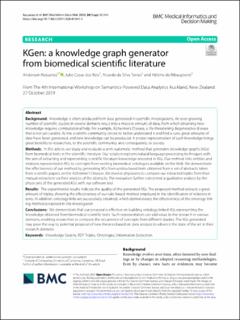| dc.contributor.author | Rossanez, Anderson | |
| dc.contributor.author | Reis, Julio | |
| dc.contributor.author | Torres, Ricardo Da Silva | |
| dc.contributor.author | Ribaupierre, Hélène | |
| dc.date.accessioned | 2021-01-11T09:52:00Z | |
| dc.date.available | 2021-01-11T09:52:00Z | |
| dc.date.created | 2020-12-28T18:05:42Z | |
| dc.date.issued | 2020 | |
| dc.identifier.citation | BMC Medical Informatics and Decision Making. 2020, 20 (314), . | en_US |
| dc.identifier.issn | 1472-6947 | |
| dc.identifier.uri | https://hdl.handle.net/11250/2722310 | |
| dc.description.abstract | Background
Knowledge is often produced from data generated in scientific investigations. An ever-growing number of scientific studies in several domains result into a massive amount of data, from which obtaining new knowledge requires computational help. For example, Alzheimer’s Disease, a life-threatening degenerative disease that is not yet curable. As the scientific community strives to better understand it and find a cure, great amounts of data have been generated, and new knowledge can be produced. A proper representation of such knowledge brings great benefits to researchers, to the scientific community, and consequently, to society.
Methods
In this article, we study and evaluate a semi-automatic method that generates knowledge graphs (KGs) from biomedical texts in the scientific literature. Our solution explores natural language processing techniques with the aim of extracting and representing scientific literature knowledge encoded in KGs. Our method links entities and relations represented in KGs to concepts from existing biomedical ontologies available on the Web. We demonstrate the effectiveness of our method by generating KGs from unstructured texts obtained from a set of abstracts taken from scientific papers on the Alzheimer’s Disease. We involve physicians to compare our extracted triples from their manual extraction via their analysis of the abstracts. The evaluation further concerned a qualitative analysis by the physicians of the generated KGs with our software tool.
Results
The experimental results indicate the quality of the generated KGs. The proposed method extracts a great amount of triples, showing the effectiveness of our rule-based method employed in the identification of relations in texts. In addition, ontology links are successfully obtained, which demonstrates the effectiveness of the ontology linking method proposed in this investigation.
Conclusions
We demonstrate that our proposal is effective on building ontology-linked KGs representing the knowledge obtained from biomedical scientific texts. Such representation can add value to the research in various domains, enabling researchers to compare the occurrence of concepts from different studies. The KGs generated may pave the way to potential proposal of new theories based on data analysis to advance the state of the art in their research domains. | en_US |
| dc.language.iso | eng | en_US |
| dc.publisher | BMC | en_US |
| dc.rights | Navngivelse 4.0 Internasjonal | * |
| dc.rights.uri | http://creativecommons.org/licenses/by/4.0/deed.no | * |
| dc.title | KGen: a knowledge graph generator from biomedical scientific literature | en_US |
| dc.type | Peer reviewed | en_US |
| dc.type | Journal article | en_US |
| dc.description.version | publishedVersion | en_US |
| dc.source.pagenumber | 24 | en_US |
| dc.source.volume | 20 | en_US |
| dc.source.journal | BMC Medical Informatics and Decision Making | en_US |
| dc.source.issue | 314 | en_US |
| dc.identifier.doi | 10.1186/s12911-020-01341-5 | |
| dc.identifier.cristin | 1863615 | |
| dc.description.localcode | © The Author(s) 2020. Open Access This article is licensed under a Creative Commons Attribution 4.0 International License | en_US |
| cristin.ispublished | true | |
| cristin.fulltext | original | |
| cristin.qualitycode | 1 | |

